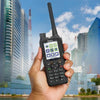
Overcoming Common Interference Issues in Radio Communication
, by Joseph Gabriel, 2 min reading time

, by Joseph Gabriel, 2 min reading time
Radio communication, while invaluable in many sectors, has its challenges. Interference remains one of the most persistent issues, affecting transmission quality and reliability. This blog post will provide tips for overcoming common interference issues in radio communication to ensure your team stays in touch when it matters most.
Several types of interference exist in radio communication. Natural interference, such as atmospheric noise, originates from natural sources such as lightning. Man-made interference, on the other hand, arises from electronic devices and industrial machinery. Understanding the nature of interference is the first step toward effective mitigation.
Identifying the sources of interference is a crucial step in addressing the issue. This process involves systematic analysis and may require specialized equipment. You can implement more targeted and effective countermeasures by pinpointing the interference’s exact origin.
Although natural interference is unavoidable, various strategies can mitigate its impact on radio communication systems. Shielding, proper grounding, and the use of filters are effective methods.
Shielding involves enclosing communication equipment in materials that block electromagnetic interference. This technique reduces the amount of external noise that reaches the equipment, improving signal quality.
Proper grounding of communication equipment helps dissipate unwanted electrical noise, reducing the potential for interference from static electricity or lightning strikes. You should perform grounding according to industry standards to ensure its effectiveness.
Filters can remove unwanted frequencies from the communication signal. These devices are particularly useful for eliminating intermodulation interference. By allowing only the desired frequencies to pass through, filters enhance the clarity and reliability of the communication signal.
While man-made interference is more controllable than natural interference, it requires a proactive approach. Regular maintenance, equipment upgrades, and adherence to best practices are essential to manage this interference.
Regular maintenance of communication equipment, including routine inspections, calibrations, and repairs, is vital to prevent and address interference. Keeping equipment in optimal condition minimizes the risk of internal interference and ensures reliable operation.
Upgrading to modern communication equipment can significantly reduce interference. Newer technologies often incorporate advanced features that enhance resistance to interference. Investing in high-quality equipment is a long-term strategy for maintaining clear and reliable communication.
Check out Atlantic Radio Communications Corp.’s selection of Icom mobile radios and accessories if you’re ready to upgrade your equipment.
Frequency hopping involves rapidly switching the communication frequency within a certain range. This method reduces the likelihood of sustained interference on any single frequency. Implementing frequency hopping requires compatible equipment and careful planning.
Spread spectrum techniques distribute the communication signal over multiple frequencies, making it more resistant to narrowband interference. This resistance makes the spread spectrum particularly effective in environments with high levels of man-made interference.
Adaptive filtering dynamically adjusts the filter parameters based on the interference characteristics, allowing for real-time interference mitigation and enhancing the communication system’s reliability. Implementing adaptive filtering requires advanced signal processing capabilities.
You can ensure consistent, clear communication for your team with these tools for overcoming common interference issues in radio communication.


